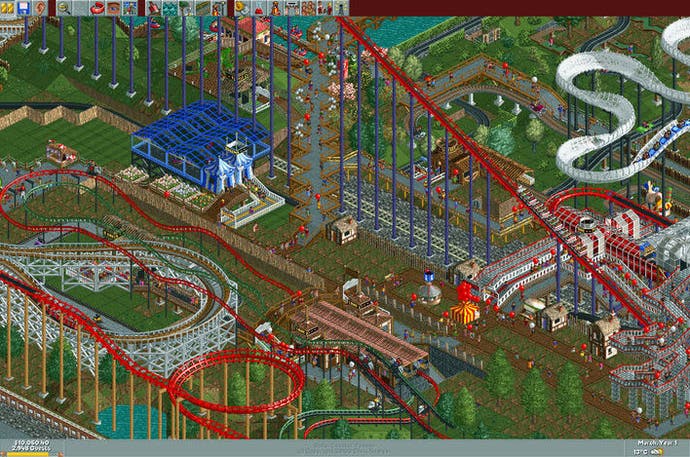Retrospective: RollerCoaster Tycoon
Ups and downs.
One: it's now horrendously unintuitive to control. Its fixed-position camera can only be snapped to four different viewpoints and three levels of zoom, none of which are entirely helpful. And you have to manoeuvre it not with the mouse, except to move the camera around, but via the bulky and intrusive user interface. I kept going for my scroll wheel, only to find it useless.
Two: I was fascinated by how much of the actual game I recalled. You know - the bits where you're not pretending to be an evil overlord, hell-bent on world destruction.
Park objectives tend to ask you to do something along the lines of 'earn X amount of money by Y year', or 'have a park rating that never drops below Z'. They're sometimes invigorating, but they're mainly a means to an end. Because the completion of each one unlocks a new park - bigger, or stranger, or with more available funds than the last one. And it's with this newfound freedom that you can get stuck into the really awesome bit of RollerCoaster Tycoon, which is of course crafting the most enormous, dazzling and ludicrous rollercoasters you could possibly care to imagine.
So, to my surprise, I remembered how best to clear the opening levels. In Forest Frontiers, it's sensible to start small, place a Ferris wheel and a merry-go-round near the entrance, then gradually expand back into the available space, lobbing in a wooden roller-coaster and a smaller one that kids will like as you near the end of your year-long objective.
Leafy Lake's customers will appreciate some swan boats to sail around in, but it's best to place some medium-intensity rides at the front and the back of the park too. In Diamond Heights you might want to introduce a few new attractions for the thrill-seekers, but its sprawling, duelling rollercoasters keep most people rather happy. You just need to sort out the toilet situation a little bit.
Later scenarios are increasingly difficult, with oddly shaped parks requiring more careful thought about how to use the environment to your advantage. And as the landscapes change, and the parks become more complex, you've to faff around with more facilities and maintenance staff. But your reward for the hard work is access to newer, faster, bigger and better rides should you pour enough money into research. The early wooden rollercoasters give way to rides where your legs dangle beneath the track, and where loop-the-loops seem to be the size of the sun.

While the game allows you to position default track designs on your park, so much of the fun comes from wrestling with your own ideas. The temptation is to make the rollercoaster with the biggest drop, the fastest speed or the most inversions, but it's not the right way to go. Most theme park-goers are after thrills, certainly, but they don't want to come away battered, bruised and nauseous.
It's all about finding that balance: about removing this bend, adding some banking to that one, making the first drop just a few metres shorter, or adding some brakes where the train would otherwise reach mind-boggling speeds. You learn that the ride's surroundings play a role on its potential for enjoyment, too: add trees and scenery near sharp corners, and it becomes more exciting, with passengers hanging on tightly as they're whisked away just before they slam into the branches.
Finally striking that perfect middle-ground, creating the impressive ride that's entertainingly frightening instead of just plain unpleasant, is a wonderful feeling. Watching those idiots finally queue up for your masterpiece of rollercoaster design, instead of moaning that they can't find the toilet they're standing right in front of, is the game's reward.
In those moments, funnily enough, you don't feel like murdering them all anymore.



